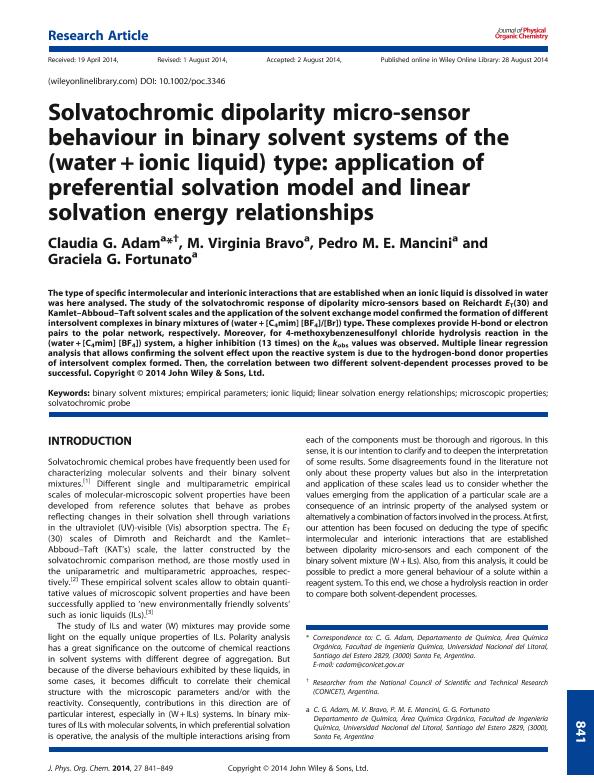Artículo
Solvatochromic Dipolarity Micro-Sensor Behavior in Binary Solvent Sustems of the (Water + Ionic Liquid) Type. Application of Preferential Solvation Model And Linear Solvation Energy Relationships
Adam, Claudia Guadalupe ; Bravo, Maria Virginia
; Bravo, Maria Virginia ; Mancini, Pedro Maximo Emilio; Fortunato, Graciela Guadalupe
; Mancini, Pedro Maximo Emilio; Fortunato, Graciela Guadalupe
 ; Bravo, Maria Virginia
; Bravo, Maria Virginia ; Mancini, Pedro Maximo Emilio; Fortunato, Graciela Guadalupe
; Mancini, Pedro Maximo Emilio; Fortunato, Graciela Guadalupe
Fecha de publicación:
08/2014
Editorial:
Wiley
Revista:
Journal Of Physical Organic Chemistry
ISSN:
0894-3230
Idioma:
Inglés
Tipo de recurso:
Artículo publicado
Clasificación temática:
Resumen
The type of specific intermolecular and interionic interactions that are established when an ionic liquid is dissolved in water was here analysed. The study of the solvatochromic response of dipolarity micro-sensors based on Reichardt ET(30) and Kamlet?Abboud?Taft solvent scales and the application of the solvent exchangemodel confirmed the formation of different intersolvent complexes in binary mixtures of (water + [C4mim] [BF4]/[Br]) type. These complexes provide H-bond or electron pairs to the polar network, respectively. Moreover, for 4-methoxybenzenesulfonyl chloride hydrolysis reaction in the (water + [C4mim] [BF4]) system, a higher inhibition (13 times) on the kobs values was observed. Multiple linear regression analysis that allows confirming the solvent effect upon the reactive system is due to the hydrogen-bond donor properties of intersolvent complex formed. Then, the correlation between two different solvent-dependent processes proved to be successful.
Archivos asociados
Licencia
Identificadores
Colecciones
Articulos(CCT - SANTA FE)
Articulos de CTRO.CIENTIFICO TECNOL.CONICET - SANTA FE
Articulos de CTRO.CIENTIFICO TECNOL.CONICET - SANTA FE
Citación
Bravo, Maria Virginia; Adam, Claudia Guadalupe; Fortunato, Graciela Guadalupe; Mancini, Pedro Maximo Emilio; Solvatochromic Dipolarity Micro-Sensor Behavior in Binary Solvent Sustems of the (Water + Ionic Liquid) Type. Application of Preferential Solvation Model And Linear Solvation Energy Relationships; Wiley; Journal Of Physical Organic Chemistry; 27; 11; 8-2014; 841-849
Compartir
Altmétricas



